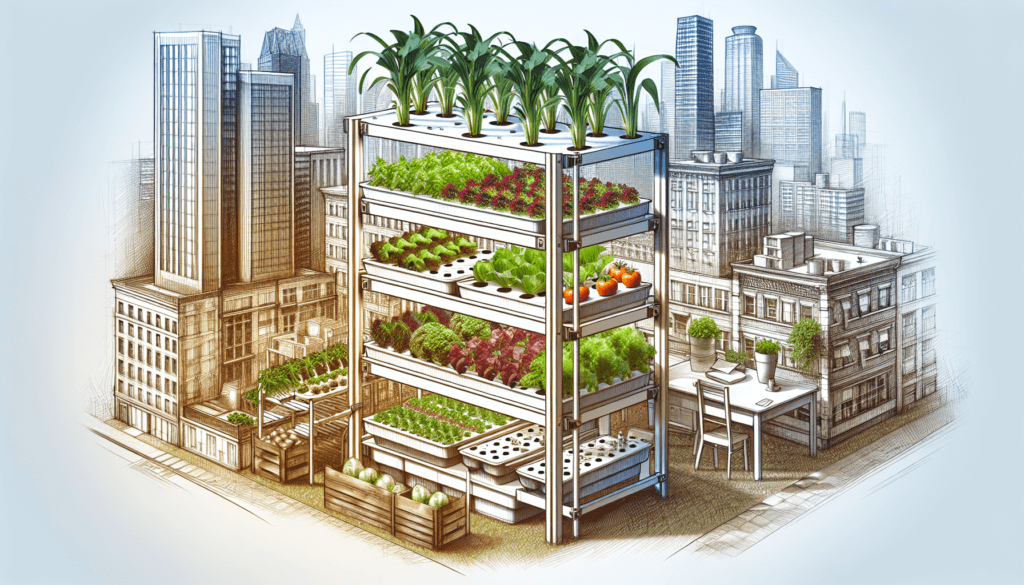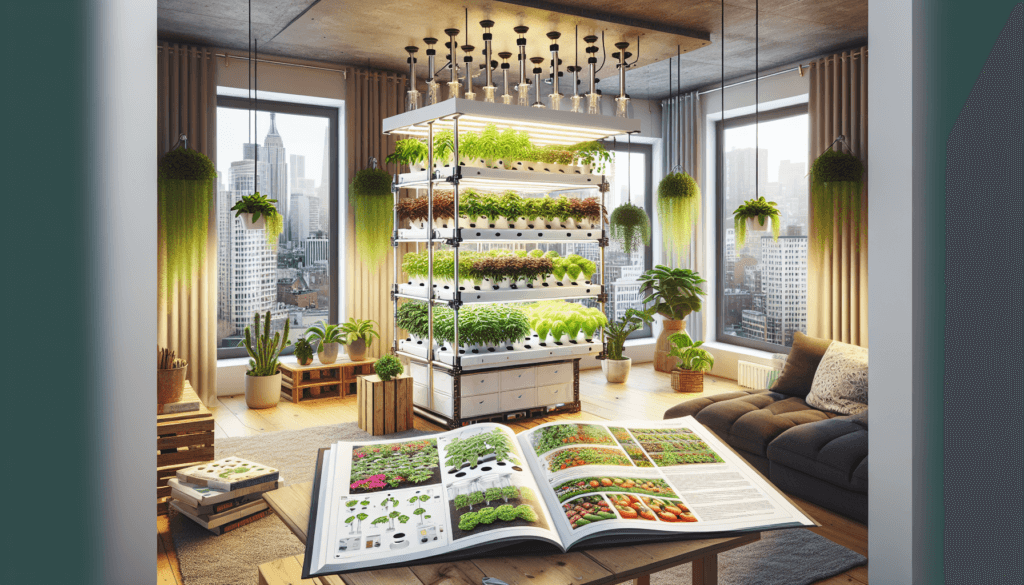Ready to take your urban gardening to the next level? Look no further than DIY hydroponic systems. With limited space in urban environments, traditional gardening can be a challenge. But with hydroponics, you can grow your own fresh produce right at home, without the need for soil. In this article, we’ll explore the world of DIY hydroponic systems and how they can transform your urban garden into a thriving oasis. Say goodbye to cramped pots and hello to an abundance of delicious fruits and vegetables.

Introduction to Hydroponics
What is hydroponics?
Hydroponics is a method of growing plants without soil, where the nutrients required by the plants are provided directly to the roots through a nutrient-rich water solution. Instead of traditional soil gardening, hydroponics relies on a growing medium that provides physical support to the roots while allowing easy access to the nutrient solution.
Advantages of hydroponics
Hydroponics offers several advantages over traditional soil gardening. Firstly, it allows for the cultivation of plants in areas where soil is poor or unavailable, such as urban environments. Additionally, hydroponics minimizes water usage as it recirculates the nutrient solution, resulting in water conservation. Furthermore, hydroponics systems require reduced maintenance, as there is no need for weeding or dealing with pests commonly associated with soil gardening. Lastly, hydroponics enables year-round gardening, providing a consistent and reliable food source regardless of seasonal variations.
Hydroponics vs. traditional soil gardening
When comparing hydroponics to traditional soil gardening, there are notable differences to consider. While traditional gardening depends on the quality of the soil, hydroponics systems can be set up anywhere because they do not rely on soil. Hydroponics also allows for greater control over the nutrients provided to the plants, leading to faster growth rates and higher yields. Additionally, hydroponics eliminates the risk of soil-borne diseases or pests, creating a more favorable environment for plant growth. However, it is important to note that hydroponics requires an initial investment in equipment and materials, which may be a disadvantage compared to the relatively low cost of soil gardening.
Benefits of DIY Hydroponic Systems
Affordability
One of the standout benefits of DIY hydroponic systems is their affordability. By constructing your own hydroponics setup, you can save money compared to pre-designed systems available in the market. DIY hydroponics often involve using readily available materials like PVC pipes, buckets, and plastic containers, which are inexpensive and easy to find. With some basic tools and a little creativity, you can create a cost-effective hydroponic system that suits your needs.
Space efficiency
Another advantage of DIY hydroponic systems is their space efficiency. In urban areas where space is limited, hydroponics allows you to maximize your gardening area as plants can be grown vertically, using shelving or stacking systems. This vertical arrangement not only saves space but also enables you to grow a larger quantity of plants in a smaller area. By utilizing vertical space effectively, you can create a beautiful and productive garden even in the smallest of spaces.
Water conservation
Water scarcity is a growing concern worldwide. DIY hydroponic systems provide a solution to this problem by conserving water. In traditional soil gardening, water often gets lost through evaporation or runoff. However, in hydroponics, water is recirculated within the system, minimizing waste. Additionally, plants in hydroponic systems require less water than those grown in soil, as the roots have direct access to the nutrient solution without having to search the soil for nutrients. This water-saving aspect of hydroponics is not only environmentally friendly but also economical.
Reduced maintenance
Maintaining a garden can be time-consuming, especially when dealing with common soil-related issues, such as weeding, fertilizing, and controlling pests. One of the major benefits of DIY hydroponic systems is their reduced maintenance. Since hydroponics eliminates the need for soil, there is no weeding involved. Additionally, the controlled environment of hydroponics minimizes the risk of pests and diseases, reducing the need for chemical pesticides. This not only saves time but also creates a low-maintenance and sustainable gardening option for urban dwellers.
Year-round gardening
Unlike traditional soil gardening, DIY hydroponic systems allow for year-round gardening. With hydroponics, you have the ability to control the environment in which your plants grow, including temperature, lighting, and nutrient levels. This control enables you to create the ideal conditions for plant growth regardless of the season. By providing the necessary light, temperature, and nutrient requirements, you can enjoy a constant supply of fresh produce throughout the year, regardless of the weather conditions outside.

Essential Components for DIY Hydroponic Systems
Reservoir
The reservoir is an essential component of any hydroponic system. It is a container that holds the nutrient solution and provides a constant supply of water to the plants. The size of the reservoir will depend on the number of plants you plan to grow and the size of your system. It is important to choose a reservoir that is large enough to hold an adequate amount of water to meet the needs of your plants.
Growing medium
In DIY hydroponic systems, a growing medium serves as a replacement for soil as it provides physical support to the plant’s roots. It should be porous enough to allow proper drainage and aeration while retaining moisture and providing stability to the plants. Commonly used growing mediums include perlite, vermiculite, coco coir, and rockwool. The choice of growing medium depends on the specific needs of the plants you plan to grow.
Water supply
A reliable water supply is crucial for any hydroponic system. As the plants in a hydroponic system grow and transpire, water consumption will increase. It is important to have a steady and clean water supply readily available. You can use tap water or filtered water, depending on the quality of your local water source. If using tap water, you may need to adjust the water’s pH level to ensure optimal nutrient uptake by the plants.
Nutrient solution
The nutrient solution is the key element in hydroponic gardening. It contains all the essential macro and micronutrients required by the plants for healthy growth. The nutrient solution is added to the water in the reservoir, providing a constant supply of nutrients to the plant’s roots. You can either prepare your own nutrient solution using commercial hydroponic fertilizers or purchase pre-made solutions. It is important to monitor and adjust the nutrient solution’s strength and pH as needed to ensure that your plants receive the proper balance of nutrients.
Pumps and tubing
Pumps and tubing are used to circulate the nutrient solution in a hydroponic system. They ensure a continuous flow of the solution to the plants, providing them with a constant supply of nutrients. A submersible pump is commonly used to move the nutrient-rich water from the reservoir to the plants. Tubing connects the pump to the growing containers, allowing for efficient distribution of the nutrient solution. When selecting pumps and tubing, it is important to consider the system’s size and the flow requirements of your plants.
Light source
Proper lighting is crucial for the growth of plants in a hydroponic system, especially in indoor setups where natural sunlight may be limited. The choice of the light source will depend on the type of plants you plan to grow and the size of your system. LED grow lights are commonly used in hydroponics due to their energy efficiency and adjustable spectrum. It is important to provide the appropriate light intensity and duration based on the specific requirements of your plants.
Air pump and air stones
Oxygen is essential for the roots of the plants to stay healthy and avoid root rot. An air pump and air stones are used to provide a continuous supply of oxygen to the root zone in a hydroponic system. The air pump pumps air through the air stones, creating small bubbles that oxygenate the water and promote root development. The size of the air pump and the number of air stones needed will depend on the size and complexity of your system.
Different Types of DIY Hydroponic Systems
Drip System
The drip system is one of the most popular and simplest hydroponic systems to set up. It involves a pump that drips nutrient solution onto the base of each plant, allowing the excess solution to drain back into the reservoir. This system is easy to maintain and can be used for a variety of plants, making it ideal for beginners in hydroponics.
Nutrient Film Technique (NFT)
The Nutrient Film Technique (NFT) is a system where a thin film of nutrient solution is continuously flowing over the roots of the plants, providing them with a constant supply of nutrients. The roots are exposed to the nutrient solution and air simultaneously, creating an oxygen-rich environment. NFT systems are ideal for smaller plants with shallow root systems, such as lettuce or herbs.
Ebb and Flow (Flood and Drain)
The Ebb and Flow system, also known as Flood and Drain, involves periodically flooding the growing containers with nutrient solution and then draining it back into the reservoir. The flooding and draining cycles mimic natural rainfall and allow the roots to absorb nutrients and oxygen efficiently. Ebb and Flow systems are versatile and can be used for a wide range of plants, making them popular choices for DIY hydroponic setups.
Wick System
The Wick system is one of the simplest and most passive hydroponic systems. It consists of a growing container with the plant and a wick made of a capillary material such as cotton or nylon. The wick draws up the nutrient solution from the reservoir to the plant’s roots through capillary action. The Wick system is easy to set up and requires minimal maintenance, making it suitable for small-scale and low-maintenance gardens.
Aeroponics
Aeroponics is a high-tech hydroponic system that involves suspending the plant’s roots in mid-air and misting them with a nutrient solution. The mist provides the roots with oxygen, water, and nutrients in an oxygen-rich environment. Aeroponics offers faster growth rates and higher yields due to increased oxygen uptake by the roots. This system requires more specialized equipment and expertise, making it more suitable for experienced hydroponic gardeners.

Choosing the Right DIY Hydroponic System
Available space
When selecting a DIY hydroponic system, consider the available space in your home or garden. It is essential to choose a system that fits within your space constraints. For smaller spaces, vertical systems like NFT or vertical towers are ideal, as they utilize vertical space efficiently. If you have more space, you could opt for larger systems like Ebb and Flow or Drip systems.
Crop selection
The type of plants you intend to grow will also influence your choice of hydroponic system. Leafy greens like lettuce and spinach thrive in NFT or Drip systems, while larger plants like tomatoes and peppers may require more space and support systems. Take into consideration the size, growth habits, and nutrient requirements of the plants you plan to grow, and choose a system that accommodates their needs.
Level of expertise
Consider your level of expertise in hydroponics when choosing a DIY system. If you are a beginner, it is recommended to start with simpler systems like Drip or Wick systems that are easier to set up and maintain. As you gain more experience and confidence, you can graduate to more advanced systems like NFT or Ebb and Flow. Remember that each system has its own learning curve, so it is important to choose a system that aligns with your level of expertise.
Budget
Finally, consider your budget when selecting a DIY hydroponic system. Different systems have different costs associated with them, ranging from inexpensive Wick systems to more expensive NFT or Aeroponics systems. Evaluate your budget and make sure to factor in the costs of equipment, materials, and ongoing maintenance. Remember that the initial investment in a high-quality system may result in long-term cost savings.
Setting Up a DIY Hydroponic System
Designing the system
Before assembling your DIY hydroponic system, it is important to plan and design it carefully. Consider the available space, the number of plants you want to grow, and the specific requirements of your chosen system and plants. Sketch out a design that includes the placement of components, flow of the nutrient solution, and accessibility for maintenance. Taking the time to design your system properly will ensure a smooth setup process.
Assembling the components
Once you have a design in place, it is time to gather the necessary components and assemble your DIY hydroponic system. Follow the instructions specific to your chosen system and refer to any reference materials or tutorials available. Take care to assemble the components correctly, ensuring a tight and secure fit. Double-check all connections and make any adjustments necessary to ensure the system functions properly.
Testing the system
Before introducing your plants to the hydroponic system, it is important to test the system and make any necessary adjustments. Fill the reservoir with water and nutrient solution, and run the system for a period of time to ensure that it is functioning correctly. Check for any leaks, make sure the water is properly circulating, and confirm that all pumps and timers are working as intended. Testing the system in advance will help avoid any potential issues once plants are introduced.
Adjusting nutrient levels
Once your system is up and running, it is important to monitor and adjust the nutrient levels based on the requirements of your plants. Use a pH meter and a TDS (Total Dissolved Solids) meter to regularly check the pH and nutrient strength of the solution. Adjust the pH levels using pH up or pH down solutions to ensure that the nutrient uptake is optimal. Monitor the nutrient strength and make appropriate adjustments by diluting or adding nutrients to maintain the desired levels.
Monitoring pH levels
Maintaining the proper pH levels is crucial for the success of your hydroponic system. Most plants prefer a slightly acidic pH range between 5.5 and 6.5. Regularly monitor the pH levels of your nutrient solution using a pH meter and make any necessary adjustments to keep the pH within the desired range. Fluctuations in pH can affect nutrient availability and overall plant health, so it is important to monitor and maintain pH levels consistently.
Maintaining the system
Regular maintenance is key to the success of your DIY hydroponic system. Keep a schedule for routine tasks such as checking nutrient levels, cleaning the reservoir, and replacing any worn-out components. Inspect the plants regularly for signs of nutrient deficiencies or pest problems. Prune plants as needed to maintain proper airflow and prevent overcrowding. By staying vigilant and proactive in maintaining the system, you can ensure the long-term health and productivity of your hydroponic garden.

Common Plants to Grow in DIY Hydroponic Systems
Leafy greens (lettuce, spinach, kale)
Leafy greens are among the easiest and most popular plants to grow in hydroponic systems. Lettuce, spinach, and kale thrive in nutrient-rich environments and have shallow root systems, making them ideal candidates for systems like NFT or Drip. With the right conditions and care, you can enjoy a continuous supply of fresh salad greens throughout the year.
Herbs (basil, mint, parsley)
Herbs are another excellent choice for DIY hydroponic systems. Basil, mint, parsley, and other herbs are known for their strong flavors and aroma. They grow well in hydroponics and require relatively less space compared to other crops. With their compact size and quick growth, herbs can be grown in small-scale systems or as a complementary addition to larger hydroponic gardens.
Strawberries
Strawberries are a favorite fruit for many and can be successfully grown in hydroponic systems. These sweet and juicy berries thrive in NFT or Drip systems, where their shallow root systems can receive constant access to the nutrient solution. Hydroponic strawberries often produce larger, tastier fruits compared to those grown in traditional soil gardens.
Tomatoes
Tomatoes are a versatile crop that can be grown in a variety of hydroponic systems. Whether you choose to grow small cherry tomatoes or large slicing varieties, hydroponics can provide the perfect environment for their growth. Systems like Ebb and Flow or Drip are well-suited for growing tomatoes, as they provide the stability, water, and nutrient access that this fruiting plant requires.
Peppers
Peppers, both sweet and hot varieties, are well-suited for hydroponic cultivation. Pepper plants thrive in warm environments with ample sunlight, making hydroponics an ideal option for urban gardeners looking to grow peppers in limited outdoor spaces. With proper care and optimal nutrient delivery, hydroponic peppers can produce high yields of flavorful and vibrant fruits.
Tips and Tricks for Successful DIY Hydroponics
Ensuring proper lighting
Proper lighting is essential for the success of your hydroponic system. If you are growing plants indoors, choose high-quality LED grow lights that emit the appropriate spectrum and intensity for the specific growth phase of your plants. Position the lights at the right distance from the plants to avoid heat stress or inadequate light exposure. Timers can be used to mimic natural daylight cycles and provide consistent lighting.
Maintaining optimal temperature
Temperature plays a crucial role in the growth and health of your hydroponic plants. Most plants thrive in temperatures between 65°F and 75°F (18°C to 24°C). Monitor and maintain the temperature within this range to ensure optimal growth. Consider using fans or ventilation systems to control temperature, especially in enclosed spaces. Additionally, be mindful of humidity levels, as excessive humidity can promote the growth of pests and diseases.
Using quality nutrients
Providing your plants with high-quality nutrients is essential for their growth and development. Research and choose a reputable brand of hydroponic nutrients that offers a balanced blend of macro and micronutrients. Follow the manufacturer’s instructions for proper mixing and application. Regularly monitor the nutrient levels in your system and make any necessary adjustments to maintain optimal nutrient concentrations.
Monitoring and adjusting pH regularly
pH levels play a critical role in nutrient availability and plant health. Regularly monitor the pH of your nutrient solution and make adjustments as needed to maintain the optimal range for your plants. Most hydroponic plants prefer a slightly acidic pH between 5.5 and 6.5. Use pH up or pH down solutions to raise or lower the pH accordingly. A stable pH level will ensure optimal nutrient uptake and promote healthy plant growth.
Preventing pests and diseases
Even in controlled hydroponic systems, pests and diseases can occur. Implement preventive measures such as regular inspection of plants, proper sanitation, and maintaining a clean growing environment. Introduce biological controls like beneficial insects or nematodes that can naturally control pests. Be vigilant in identifying and addressing any signs of pest infestations or diseases to prevent their spread and protect your plants.
Harvesting and storing produce
Harvesting your hydroponically grown produce at the right time is crucial to ensure optimal flavor and quality. Each plant has specific signs to look for when determining the right time to harvest. Follow guidelines for each crop and harvest when the fruits are ripe and ready. Properly store harvested produce in a cool and dry environment to preserve freshness and extend shelf life. Enjoy the fruits of your hydroponic labor at their peak!

Troubleshooting Common Issues
Algae growth
Algae growth is a common problem in hydroponic systems exposed to light. To prevent algae growth, keep the nutrient solution reservoir in a dark or opaque container. Minimize light exposure to the nutrient solution by covering the reservoir or using light-blocking materials. Additionally, ensure proper water circulation and aeration, as stagnant water can promote algae growth.
Root rot
Root rot is a condition caused by excess moisture and poor oxygenation of the roots. To prevent root rot in your hydroponic system, maintain a proper balance between watering and drainage. Ensure that the growing medium provides adequate aeration to the roots. Avoid overwatering and consider using air stones or increasing oxygenation to prevent the buildup of stagnant water in the root zone.
Clogged tubing
Clogged tubing can disrupt the flow of the nutrient solution in your hydroponic system. Regularly inspect the tubing for any clogs or blockages caused by debris or buildup. Clean the tubing or replace it as needed. Implement a filtration system to prevent debris from entering the tubing and causing clogs. Regular maintenance and cleaning of the system can help prevent clogging issues.
Nutrient deficiencies
Nutrient deficiencies can occur when the plants are not receiving an adequate balance of essential nutrients. Monitor the nutrient levels in your system regularly using a TDS meter and adjust the nutrient solution strength accordingly. If you notice specific nutrient deficiencies, supplement the nutrient solution with the missing elements. It is important to maintain a balanced nutrient solution to ensure optimal plant growth and productivity.
pH fluctuations
pH fluctuations can negatively impact nutrient availability and plant health. Maintaining a stable pH is crucial for proper nutrient uptake by the plants. Regularly monitor the pH levels and make small adjustments using pH up or pH down solutions as needed to maintain the desired range. Ensure that the pH meter is calibrated regularly to ensure accurate readings. Regular monitoring and adjustment will help avoid pH fluctuations and maintain a stable growing environment.
Conclusion
DIY hydroponic systems provide an accessible and sustainable solution for urban gardening. The affordability, space efficiency, water conservation, reduced maintenance, and year-round gardening capabilities make it an attractive option for urban dwellers. By understanding the essential components, different types of systems, and the process of setting up and maintaining a DIY hydroponic system, you can enjoy the benefits of fresh, homegrown produce right at your fingertips. With a little knowledge, creativity, and dedication, you can embark on a rewarding journey of successful DIY hydroponics and bring the joy of gardening into your urban space.


